-
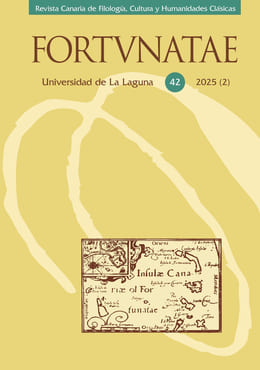 Núm. 42 (2025)
Núm. 42 (2025)
Fortunatae manteniendo el compromiso académico de presentar trabajos de calidad en todo el ámbito de los Estudios Clásicos y reafirmando su carácter internacional recoge en su número 42 siete artículos y tres recensiones.
Thomas Acevedo Algarbe, Universidad de Buenos Aires, abre el número con el artículo “La pudicitia y el deseo sexual en la representación de Octavia y Popea. Paradigmas histórico-mitológicos de la femineidad en los Annales de Tácito y la Octavia de pseudo-Séneca”, proponiendo el contraste entre los dos personajes a partir de la noción de pudicitia, en función de sus comportamientos y protocolos sexuales asociados, así como el desenvolvimiento de estos dos modelos de femineidad como posiciones diferentes respecto de la violencia imperial, y los puntos de contacto y divergencia que, a partir de ahí, se pueden establecer entre el género historiográfico y la tragedia romana. “La fuerza de la prueba: sobre verosimile y probabile en la retórica ciceroniana” es la propuesta de Lorelei Cisneros y Marcela Coria, Universidad Nacional de Rosario, partiendo de textos ciceronianos que abordan la compleja relación entre falsum, verum y el problema del conocimiento, desde donde se da entrada a una serie de conceptos que, paradójicamente, distan de sostener la oposición entre lo verdadero y lo falso, y al examen de las peculiaridades semánticas de verosimile y probabile y su reelaboración desde la Retórica de Aristóteles. Anthofili Kallergi, de la Universidad griega de Ioannina, en “The Prologue of Plautus’ Menaechmi and the Opening Scene of Shakespeare’s The Comedy of Errors (i.1.1-160): a Comparative Analysis”, examina cómo The Comedy of Errors de Shakespeare, específicamente la escena I.1, se aparta de Menaechmi de Plauto en su adaptación e interpretación creando desde el comienzo de su obra una trama más compleja. “La decoración de tema pompeyano en la casa de Schliemann en Atenas”, de Antonio Ramón Navarrete Orcera, de la UNED, estudia los frescos que decoraban la casa del arqueólogo Heinrich Schliemann en Atenas, y demuestra que reproducen fielmente, con su temática mitológica, frescos de las principales casas halladas en Pompeya, que se conservan hoy en el Museo Arqueológico de Nápoles. Ángel Ruiz Pérez, Universidad de Santiago de Compostela, con el trabajo “La contención de los Alcmeónidas, según Heródoto: la boda de Agarista y Megacles”, estudia en detalle el episodio del certamen de bodas organizado por el tirano Clístenes de Sición para su hija Agarista, que conservamos solamente en Heródoto (6.126-131), realizando un análisis exhaustivo del término central de todo el episodio, el verbo κατέχω, clave de comprensión del conjunto, contextualizándolo en el estudio en profundidad de los aspectos históricos, literarios y folklóricos más definitorios del episodio. Los autores Gelbart Souza Silva y Cláudio Aquati, de la brasileña Universidade Estadual Paulista, estudian en “Fellini-Satyricon, libera riduzione dal romanzo di Petronio Arbitro: Uma leitura conjunta” cómo y en qué medida una amplia variedad de géneros literarios, discursos y lenguajes utilizados en la formación de la crítica y creativa novela romana de Petronio se unen, se transponen, se reorganizan y se transforman en el discurso fílmico moderno de Federico Fellini. Por último, Mariano Zarza, de la Universidad Nacional de La Plata, en “Conocimiento y gobierno de sí mismo en la Sátira 2, 7 de Horacio”, muestra cómo los roles se invierten en dicha sátira, ya que el satírico no es el poeta Horacio sino su esclavo Davo, resultando que, al darle voz a este personaje para burlarse de sus propios defectos, el poeta demuestra autocrítica, y quizá desarrolla, de manera sutil, una invectiva contra el poder. -
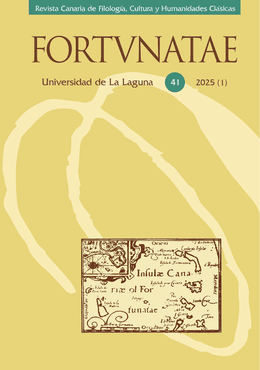 Núm. 41 (2025)
Núm. 41 (2025)
El número se abre con el artículo de Juan Manuel Arriaga Benítez, “La Tetis que Júpiter rechazó: el cierre hesiódico de destronamientos en una écfrasis valeriana (Arg. I, 130-139)”, que parte de una de las pinturas que adornan la nave de los Argonautas en Valerio Flaco, en la que se describen brevemente las bodas de Tetis y Peleo. Este adorno ha tenido dos interpretaciones predominantes, la conquista del océano y la anticipación del matrimonio entre Medea y Jasón. No obstante, en este artículo se propone una tercera interpretación relacionada con el ciclo de alternancias por destronamiento de una deidad suprema por otra, con el cierre de este ciclo a cargo de Zeus/Júpiter como dios de poder indisputable. En “El léxico de las zonas erógenas en la Antología Palatina”, Esteban Calderón Dorda presenta un estudio sobre el léxico de las zonas erógenas en los epigramistas de la Antología Palatina, pero haciendo un especial hincapié sobre la incidencia que en ellos tiene el lenguaje popular en convivencia con términos técnicos y mostrando una maestría poética en la combinatoria de todos ellos con juegos anfibológicos o eufemísticos de alta calidad. Por su parte, Soledad Correa trata de la muerte, el drama y la ejemplaridad como los tres ejes centrales para abordar el epistolario de Séneca en “Non trepidabo ad extrema: mors, performance y ejemplaridad en Sen., Epist. 54”. La carta escogida representaría una meditatio mortis y establece el momento de la muerte como una performance decisiva para la valoración de la propia vida. Esta carta se puede leer como la puesta en escena de un ensayo de su suicidio forzado, cuyo relato posterior en Tácito (Ann. 15, 60-64) nos llevaría a interpretar una cierta coherencia con lo teorizado y un acuerdo entre oratio y vita. La “edición crítica de Pseudo-Hipócrates, De venae sectione (extracto de Galeno, De cur. rat. per venae sect.)” de Elsa García Novo recoge la edición de un pequeño tratado sobre la flebotomía atribuido mayoritariamente a Hipócrates y que recogen trece manuscritos, tratándose en realidad de un extracto de Galeno, de su De curandi ratione. El trabajo consigue establecer un stemma de los textos agrupándolos en tres familias, y en su comparación con el original de Galeno llegan a aportar algunas lecciones importantes para este. Sobre las “Inscripciones griegas en la decoración de la casa de Schliemann en Atenas” versa el artículo de Antonio Ramón Navarrete Orcera. El estudio muestra cómo en su mayoría (son un total de 48), aparte de su adecuación temática a la sala en la que están ubicadas, se caracterizan por su valor preceptivo y moral, habiendo sido extraídas de los autores griegos más importantes, de las sentencias de los siete sabios y de fragmentos conservados de la Antología Palatina, mostrando el dominio de los textos que tenía el famoso arqueólogo. Joaquín Pascual-Barea nos presenta un estudio sobre la toponimia de la localidad conquense de Noheda, argumentando su procedencia de Novata, nombre de una villa romana próxima, en la que se conservan algunos mosaicos que representan obras teatrales, y en los que aparecen referencias escénicas a un relato de Apuleyo o un resto textual que nos lleva al Anfitrión de Plauto. A la etimología está dedicado el último artículo de la serie, bajo la autoría de María Teresa Santamaría Hernández: “Etimología de ajar y del ajo perdido, y su relación con alear y lío”. El verbo español ajar (allēuare) se vincula formal y semánticamente con un sustantivo ajo, que es diferente, por su origen y significado, del nombre homógrafo y homófono que designa el vegetal usado frecuentemente como ingrediente culinario. Se revisan otras interpretaciones diferentes de ajar propuestas anteriormente. Se analizan y explican los distintos usos y acepciones en español del término ajo derivado de ajar, revelando así su conexión con la palabra lío. La diferenciación formal y semántica de ambos ajos permite aclarar algunas confusiones sostenidas en el ámbito lexicográfico a lo largo del tiempo.
Completan el número dos recensiones sobre sendas obras recientes: Guus Kroonen (ed.), Sub-Indo-European Europe, a cargo de Marcos Medrano Duque, y Francisco García Jurado, Teoría de la tradición clásica. Conceptos, historia y métodos, reseñada por Genaro Valencia Constantino. -
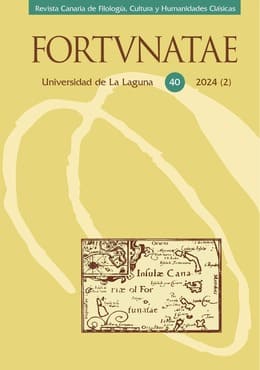 Núm. 40 (2024)
Núm. 40 (2024)
El número 40 de Fortunatae incluye ocho artículos (seis en español y dos en portugués) y cuatro reseñas, procedentes de Argentina, Brasil, Canadá, México y España, manteniéndose así el carácter internacional de esta publicación.
Luis Amela Valverde centra su estudio en la numismática de época republicana, con especial atención a los denarios de la serie RRC 455 de C. Ancio Restión. Reyes Bertolín Cebrián desgrana los paisajes utópicos de la Odisea para mostrar que, en su opinión, estos crean una expectativa que a veces entra en contradicción con la base social y psicológica de sus habitantes. Por su parte, Gabriel Laguna Mariscal nos lleva al campo de la tradición clásica rastreando el tópico literario del carpe diem en algunas de las canciones de The Beatles. El debate humanístico en torno al latín hablado por los romanos nos llega de la mano de Fábio Frohwein de Salles Moniz con su propuesta de traducción de un texto de Bruni. Miguel Ángel Ramírez Batalla analiza las cosmovisiones enfrentadas de cristianos, por un lado, y de las principales escuelas clásicas filosóficas (estoicos, platónicos o neoplatónicos), por el otro, en los siglos II y III d. C. A continuación, Luis Manuel Ruiz García revisa las metáforas universales relacionadas con el mar y el agua en general en el poema 4 de Catulo. Sigue la colaboración de Breno Battistin Sebastiani que se centra en el estudio filológico-historiográfico del desarrollo de comunidades griegas fuera de su territorio original, y las implicaciones que se desvelan en términos de exilio, deportación y otros aspectos cercanos, como las redes de comunicación y apoyo. Por último, Ana C. Vicente Sánchez desarrolla el estudio semántico del término κόμπος en los textos trágicos, con una extensa variación de derivados léxicos.
Completan el número cuatro recensiones sobre publicaciones recientes de Graham Zanker, Eric H. Cline, Manel García Sánchez y las Epistolas de Petrarca. -
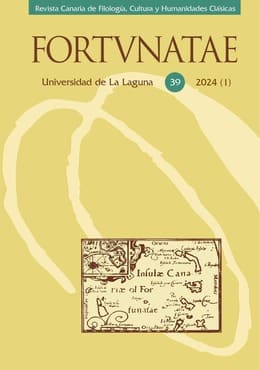 Núm. 39 (2024)
Núm. 39 (2024)
El número 39 de Fortunatae incluye cinco artículos (cuatro en español y uno en inglés) y una reseña, que desarrollan un amplio abanico de temas: los poemas de Opiano en Grecia y Eliano en Roma sobre la vida animal y su difícil relación con el hombre; la deificación de Augusto en las Geórgicas de Virgilio; el papel de la alimentación y la hegemonía naval ateniense en la historia del universalismo político; la tradición oracular de Grecia a través de la epigrafía; y los tópicos ciceronianos en la obra humanística de Juan de Mariana.
En el primer artículo, Alejandro Abritta (Universidad de Buenos Aires) estudia el contenido y desarrollo del pasaje de Opiano de Cilicia (Halieutica 5.519-588) en el que explica el procedimiento de la captura de los delfines por parte de los pescadores tracios, con una descripción altamente humanizada del sacrificio del delfín hembra tras la muerte de su cría y resalta su similitud o dependencia en relación con el relato que también hace Eliano (1.17 = 1.18 Hercher) del mismo tema.
Julia Alejandra Bisignano (Universidad Nacional de La Plata), analiza el ‘mito augusteo’ como una asociación entre modelos divinos (Apolo principalmente), heroicos (Aquiles y Hércules) y regios (Rómulo, Numa y Alejandro), y propone que su creación fue el resultado de un proceso social que se fue imponiendo a partir de imágenes, ceremonias, actos públicos o también de la literatura. El trabajo estudia el procedimiento de mitologización que se aprecia en la obra de Virgilio con un desarrollo entre el interés político y el literario.
Desde la UNAM de México, Diego Alexander Olivera se propone demostrar la existencia de un anhelo universalista por parte de la ciudad de Pericles, previamente a la aspiración de dominio universal que se suele atribuir a los posteriores reyes helenísticos.
Francisco Sánchez Torres (Universidad de Córdoba) se adentra en el espacio simbólico y retórico del locus amoenus en los prefacios de la obra tratadística de Juan de Mariana, como un ejercicio ciceroniano muy popular en la tratadística renacentista.
Por último, Dimitris Vitalis (Universidad de Chipre), ofrece una reevaluación de una consulta oracular conservada en el anverso de una placa de plomo que incluye una reinterpretación de la última línea del texto. -
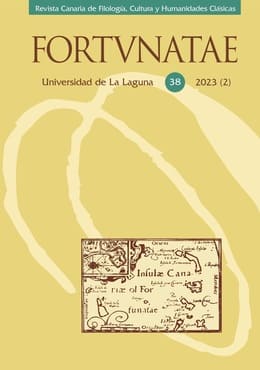 Núm. 38 (2023)
Núm. 38 (2023)
Cinco artículos y tres reseñas conforman el número 38 de la revista Fortunatae que, atendiendo al carácter misceláneo de esta publicación, acoge trabajos de diversos ámbitos de la Filología Clásica. Una amplia temática que va desde la filosofía y el ascetismo griegos al estoicismo romano de Séneca, de la historiografía de Tácito a las artes memorísticas tardomedievales, pasando por los estudios de indoeuropeo. Temática general que permite o sirve de pretexto para el estudio pormenorizado de algunas cuestiones específicas, como el análisis del tópico literario locus amoenus que Diego Andrés Cardoso Bueno realiza en el tratado De vita contemplativa de Filón de Alejandría; las cuestiones de etimología y antroponimia griegas que Marcos Medrano Duque expone en su investigación de las formas Κασ(σ)-, Κασσι- y Καστι; el orden de palabras que Carles Padilla-Carmona considera un rasgo significativo y un recurso estilístico esencial en Tácito; las artes de memoria de origen escolástico que Marta Ramos Grané pone al servicio de cuestiones tan actuales como la inteligencia artificial; y, por último, el trabajo de Genaro Valencia Constantino que trata de demostrar como el estudio pormenorizado del léxico de Séneca puede llevar a matizar o explicar mejor las ideas filosóficas de este autor.
En lo que atañe a las reseñas, Javier del Hoyo Calleja nos presenta el bien documentado libro de Fernando García Romero, Lechuzas a Atenas. Pervivencia hoy del refranero griego antiguo. Ángel Martínez Fernández, por su parte, comenta, en una primera reseña, con concisión y claridad, la publicación de las aportaciones del XIV Simposio Internacional de la Sociedad Española de Plutarquistas celebrado en La Laguna en 2022, y, en una segunda recensión, analiza paso a paso la salida a la luz de la obra sobre epigrafía griega «IG X 2, 1 Suppl. 2: Inscriptiones Thessalonicae et Viciniae – Supplementum alterum: Addenda, Indices, Tabulae». -
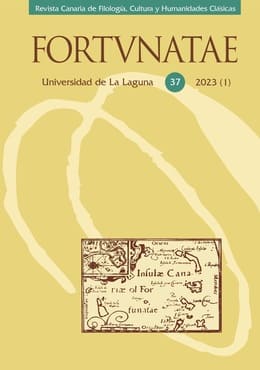 Núm. 37 (2023)
Núm. 37 (2023)
El número 37 de Fortunatae en sus siete articulos y dos recensiones reúne un amplio abanico de temas que van desde la historiografía clásica hasta la oratoria de Esquines o Dinarco, pasando por la gramática del Quinientos, la epigrafía minoica, la retórica clásica tardía, la crítica textual o la exégesis griega cristiana.
En el primer artículo, Ignacio Carral discute los puntos de relación que pueda haber entre la obra de Tito Livio y la de Polibio. Leonardo Ferreira y Melyssa Cardozo estudian la evolución que el término “letra” presenta en las gramáticas en lengua portuguesa del siglo XVI y su relación con la evolución de esa disciplina a partir del Renacimiento. En el ámbito de la epigrafía griega, el artículo de Christina Papadaki plantea la hipótesis de que el mensaje que aparece en un número de joyas minoicas pueda tener un sentido apotropaico o de protección. Liliana Pégolo y Alexis Robledo se ocupan de la función de la écfrasis, que el autor bilingüe grecolatino C. Claudiano, representante de los finales de la Segunda Sofística, eleva a la categoría de vertebradora de todo su relato épico y no como mera figura retórica. Pedro E. Rivera se centra en aspectos de crítica textual, analizando varios términos de la tradición manuscrita de la Biblioteca de Focio cuya interpretación errónea puede haber llevado a una transmisión inadecuada del texto. María Alejandra Valdés analiza el proemio del Hexámeron de Basilio de Cesarea desde el punto de vista de la preceptiva y retórica clásicas y la función que estas juegan en la exégesis bíblica. En el último de los artículos, Silvia Vergara expone parte de los resultados de sus estudios sobre léxico religioso e irreligioso en la oratoria griega clásica y sus valores semánticos como contribución a un mejor conocimiento del contexto político en que se desenvolvieron y al papel que desempeñaron en relación con el uso de los recursos retóricos. -
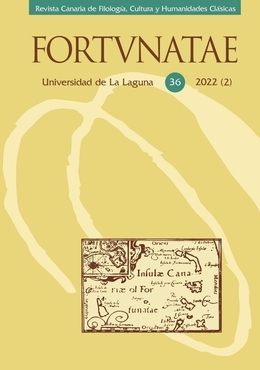 Núm. 36 (2022)
Núm. 36 (2022)
La revista Fortunatae en su número 36 ofrece una vez más una amplia variedad de temas, dentro del ámbito de los Estudios Clasicos, con sus seis artículos y tres reseñas. En el primer artículo, «Las odas 1, 4; 4, 7 y 4, 12 de Horacio comentadas por Porfirión, Pseudo-Acrón, Landino y Mancinelli (Venetiis 1492)», de Carlos Amado Román, se analizan las divergencias y similitudes entre escolios antiguos y comentarios renacentistas referentes a algunas odas de Horacio y su exégesis en el Horatius cum quatuor commentariis (Venecia, 1492). Sebastián Eduardo Carrizo en «Las emociones de lo risible: la invectiva cómica y la manipulación emocional en la yambografía griega arcaica y en la comedia antigua» analiza en Arquíloco de Paros e Hiponacte de Éfeso, por un lado, y en Aristófanes, por el otro, las formas de manipulación de las emociones en la construcción risible del ἐχθρός (‘adversario’) a través del ψόγος (‘invectiva’) y su valor en la constitución misma de un género literario. La tercera contribución de este número, «Nuevos datos sobre una receta acéfala del Liber medicinalis Collegii Balliolensis: un Electuarium dia prassiu maior», de Arsenio Ferraces Rodríguez, estudia los problemas de identificación y autoría que presenta una receta sin título y su relación con otra receta gemela del mismo libro desde el punto de vista de la transmisión textual. En el siguiente trabajo, Sanae Kichouh Aiadi analiza la reformulación del mito de Deméter y Perséfone desde un punto de vista psicoanalítico en «Louise Glück’s ’Persephone the Wanderer’ read from a psychoanalytic and Classical Receptions perspective». También en la línea de la tradición clásica en época contemporánea, se desarrolla la aportación de Mónica Padilla Navarro titulada «The reception of Aristophanes’ Lysistrata from a contemporary perspective: David Stuttard’s Lysistrata, or Loose Strife». El artículo analiza la adaptación de la obra por parte del dramaturgo y director escénico británico y los recursos que utiliza para llegar al público manteniendo el propósito original del texto a la vez que le confiere un claro sesgo de actualidad en el tratamiento de los personajes y su puesta en escena. En el último de los artículos, «Μινωικές αποθέσεις θεμελίωσης: τυπολογία - μορφολογία, περιεχόμενο και λειτουργία» (Depósitos de fundación minoicos: tipología, morfología, contexto, contenido e interpretación) Christina Papadaki examina, mediante los testimonios materiales conservados, los rituales de fundación minoicos (iniciación y consagración de edificios) y sus fórmulas sacrales en busca de la conservación y prosperidad del lugar.
-
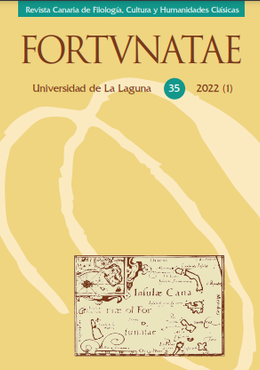 Núm. 35 (2022)
Núm. 35 (2022)
El número 35 de la revista Fortunatae recoge un total de nueve artículos y una reseña, en cuatro idiomas diferentes (español, inglés, italiano y portugués). Una vez más, el carácter multidisciplinar y la originalidad y seriedad de las propuestas, junto con su sesgo internacional, protagonizan el contenido de la revista.
Entre los cinco artículos que se mueven en el ámbito de la Filología Griega, Evelia Arteaga trata del uso del término φιλοψυχία (‘amor por la vida’) en diversos géneros de la literatura griega y su concurrencia en contextos tanto de sentido positivo como negativo. Eirini Briakou incursiona en la Hécuba de Eurípides con un análisis desde el punto de vista de la audiencia, destacando cómo la atención hacia esta se recoge en la propia obra. También el teatro, pero esta vez en relación con aspectos métricos (la llamada «cesura media»), es el tema del artículo de Máximo García y Felipe Hernández. El hecho histórico de la mutilación de los Hermes en el 415 a.C. y su tratamiento desde el punto de vista de historiadores, biógrafos y oradores griegos ocupa el trabajo de Priscilla Gontijo. La ζηλοτυπία (‘celos amorosos’), testimoniada en un extenso número de fuentes y géneros de época imperial griega, es la materia del artículo de Claudia Palma. Por último, y entre la Filología Árabe y la Griega, Adalberto Magnelli y Giuseppe Petrantoni hacen una nueva propuesta de hechos históricos ocurridos en la Sicilia del siglo XII con base en textos árabes y referencia a fuentes griegas.
Ya entre los estudios de Filología Latina, Guillermo Aprile trata la aparición y consideración de la figura del médico en diferentes textos historiográficos. José Medrano se centra en dos párrafos de las Naturales Quaestiones para estudiar el tema senequista de vivir conforme a la naturaleza a través de la sabiduría. En el campo de la didáctica se introduce el artículo de Eveling Garzón, que analiza el léxico de los textos latinos en los exámenes de acceso a la universidad en España, y concluye con una propuesta.
Finalmente, aparece una cuidada reseña de Nicolás Russo sobre la última edición bilingüe italiana de la Germania de Tácito. -
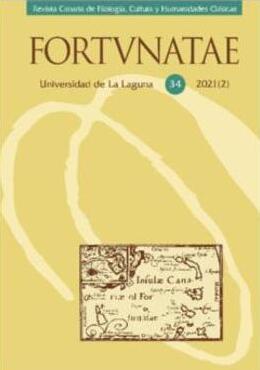 Núm. 34 (2021)
Núm. 34 (2021)
El número 34 de la revista Fortunatae está dedicado a los primeros treinta años de la Revista, que comenzó su andadura en 1991. Para esta efeméride se invitó a publicar a quienes lo habían hecho en los dos primeros números, así como a aquellos que, habiendo publicado en otras ocasiones, fueran especialistas, de una u otra forma, en el lema que se propuso como preferente, y que hacía honor al propio nombre de la revista: «Mακάρων νήσοι / Insulae Fortunatae y otros universos insulares». La respuesta fueron once contribuciones de un altísimo nivel recogidas en el citado número, que no solo se ocupan del tema de las Afortunadas y su relación con Canarias sino también con otras islas atlánticas o las islas de las llamadas Indias Orientales. Todo ello recorriendo un espacio temporal que se extiende desde la Antigüedad Clásica hasta el humanismo de los siglos XVI y XVII, en una clara simbiosis entre la Filología y la Historia.
-
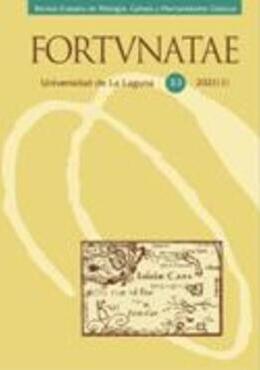 Núm. 33 (2021)
Núm. 33 (2021)
El número 33 de la revista Fortunatae reúne en sus 248 páginas un total de once artículos y tres reseñas de libros en cinco idiomas diferentes (español, francés, griego, inglés e italiano). Atendiendo a la multidisciplinariedad que caractariza a esta publicación, tres de sus artículos se dedican a epigrafía griega en diferentes momentos y aspectos: dialectología cretense (Bile), inscripciones bizantinas (Magnelli) y cerámica helenística (Tsatsaki). La literatura está representada por los trabajos sobre Sófocles y Esquilo de Helen Gasti y Andrea Sánchez respectivamente. A la tradición clásica se adscriben las aportaciones de López Férez sobre la General Estoria, y el de Milagros del Amo sobre el comentario de Nebrija sobre Persio. Dentro del apartado más estrictamente lingüístico, María Isabel Jiménez y Eveling Garzón, dedican su estudio a la cuestión de las colocaciones latinas. Por su parte, el artículo de Jesús Peláez gira en torno a la organización semántica en diccionarios neotestamentarios griegos. El arabista Miguel Ángel Lucena analiza un tratado fisiognómico sirio del siglo XIII y sus fuentes griegas y por último, desde un enfoque histórico y cultural, Styliani Voutsa traza un recorrido histórico de la presencia de intelectuales helenos en la universidad helmántica desde el Renacimiento.
-
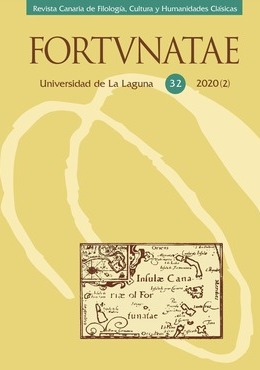 Núm. 32 (2020)
Núm. 32 (2020)
El número 32 de Fortunatae está dedicado al profesor Ángel Martínez Fernández y -con sus 854 páginas y un total de 53 artículos y dos reseñas en hasta siete idiomas diferentes- supone el más amplio y variado volumen en la historia de la publicación.
Dada la dedicación preferente del Dr. Martínez, la disciplina con el mayor número de contribuciones es el de la epigrafía, tanto griega como latina (11 artículos). Pero en este multidisciplinar volumen, también están representadas otras especialidades, que ponen de manifiesto el interés despertado entre los investigadores por este merecido homenaje. Tradición clásica, crítica textual, literatura griega y lingüísitica griega son los grandes temas bajo los que se cobijan artículos sobre los más variados temas: cine, música, historia, filosofía, religión, mitología, medicina, agricultura, etc. -
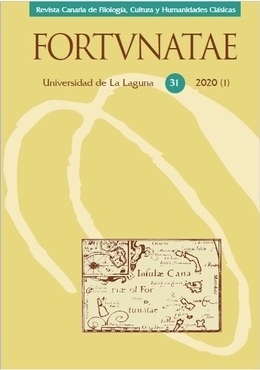 Núm. 31 (2020)
Núm. 31 (2020)
El número 31 de Fortunatae, reúne diez artículos sobre tradición y recepción clásica, estudios bíblicos, literatura griega y mitología, entre otros temas adscritos a la Filología clásica y su pervivencia. Completan el volumen cinco recensiones.
-
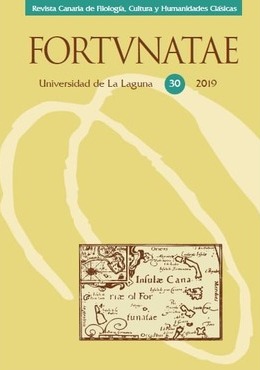 Núm. 30 (2019)
Núm. 30 (2019)
Con el número 30 de Fortunatae se rinde homenaje a Juan Barreto Betancort, profesor del departamento de Filología Clásica y Árabe, y muy ligado a esta publicación de la que fue secretario de 2006 a 2009 y director desde 2010 a 2016. Este volumen reúne una serie de artículos sobre los estudios bíblicos, principal línea de investigación del homenajeado.
-
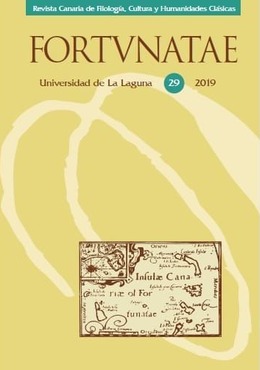 Núm. 29 (2019)
Núm. 29 (2019)
El número 29 de Fortunatae acoge siete artículos que abordan diversos temas relacionados con los Estudios clásicos y su pervivencia. Completan el volumen siete recensiones.
-
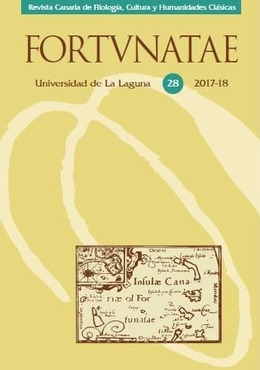 Núm. 28 (2018)
Núm. 28 (2018)
Veintiseis artículos conforman el número 28 de Fortunatae que está dedicado a la memoria de Isabel García Gálvez, profesora titular de Filología Griega de la Universidad de La Laguna. Compañeros, colegas y amigos se unen en este homenaje, en el que tienen cabida los más diversos temas relacionados con el estudio de la lengua y la literatura clásica y su pervivencia.
1-15 de 42
Siguiente
e-ISSN: 2530-8343
ISSN: 1131-6810 (ya no activo)
DOI: 10.25145/j.fortunat
Idioma
Información
Fortunatae
e-ISSN (edición digital): 2530-8343
ISSN (antigua edición impresa): 1131-6810. ISSN ya no activo
DOI: 10.25145/j.fortunat
Edita: Universidad de La Laguna
Contacto: Revista Fortunatae
Departamento de Filología Clásica, Francesa, Árabe y Románica
Este trabajo está bajo una licencia CC BY-NC-ND 4.0




